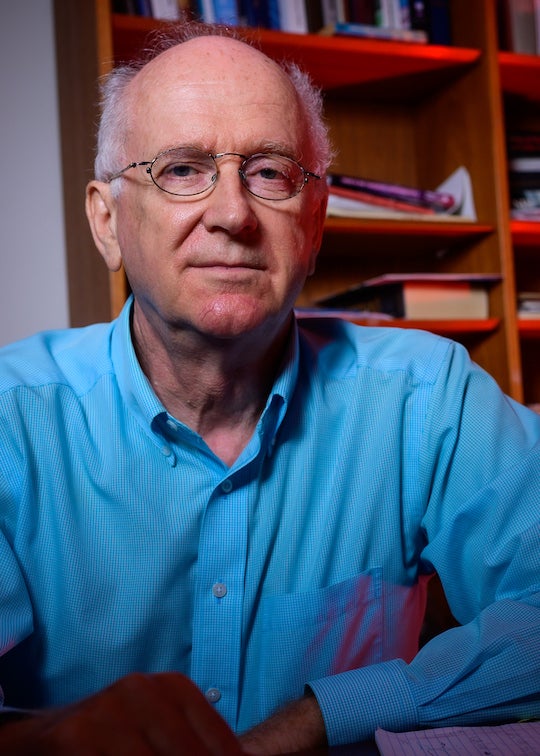Rice University materials scientist Boris Yakobson and collaborators uncovered a property of ferroelectric 2D materials that could be exploited as a feature in future devices.

Because they bend in response to an electrical stimulus, single-layer ferroelectric materials can be controlled to act as a nanoscale switch or even a motor, according to the study published in ACS Nano.
Single-layer or 2D materials are typically made up of a single layer of atoms, meaning they are only a few nanometers thick. They have received significant attention in recent years due to their physical, electrical, chemical and optical properties, which makes them useful in applications ranging from consumer electronics to medical and industrial technologies.
“2D materials are very thin and very flexible,” Yakobson said. “In single-layer ferroelectrics, this produces an unexpected spontaneous, active bending behavior.”
“The novelty we found in this study is that there is a connection or coupling between the ferroelectric state and the bending or flexing of the material. This work combines the discovery or prediction of a fundamental property of a class of 2D materials with a practical application angle.”
Ferroelectrics are materials made up of negative and positive ions that can shift to produce spontaneous polarization, meaning the ions segregate based on their electrical charge.

“The interesting thing is that the atoms are not identical,” explains Jun-Jie Zhang, a Rice postdoctoral research associate and lead author on the study. “Some of them are larger, and some are smaller, so the layer symmetry is broken.”
Polarization drives the larger atoms to one side of the 2D-material layer and the smaller atoms to the other side. This asymmetrical distribution of the atoms or ions causes the material surface to bend in ferroelectric state.
“So instead of remaining flat, in ferroelectric state the material will bend,” Yakobson said. “If you switch the polarization – and you can switch it by applying electrical voltage – you can control the direction in which it will bend. This controllable behavior means you have an actuator.
“An actuator is any device that translates a signal – in many cases an electrical signal, but it can be a different kind of signal – into mechanical displacement or, in other words, movement or work.”
The study looked at 2D indium phosphide (InP) as a representative of the class of ferroelectrics for which it predicts this property.
“This new property or flexing behavior has to be tested in a laboratory for specific substances,” Yakobson said. “Its most likely use will be as a type of switch. This behavior is very fast, very sensitive, which means that with a very tiny local signal you can maybe switch on a turbine or electrical engine, or control adaptive-optics telescopes’ mirrors. That’s basically the essence of these actuators.
“When you drive your car, you have a lot of knobs and switches and it makes everything really easy. You don’t have to crank open your car window anymore, you can just turn on a switch.”
Yakobson is Rice’s Karl F. Hasselmann Professor of Materials Science and NanoEngineering. Taif University chemist Tariq Altalhi is a co-author on the study.
The U.S. Army Research Office (W911NF-16-1-0255) and the Office of Naval Research (N00014-22-1-2753) supported the work, with computing resources provided through the ACCESS program by the National Science Foundation (grants 2138259, 2138286, 2138307, 2137603, 2138296).
-30-
- Peer-reviewed paper:
-
Flexo-Ferroelectricity and a Work Cycle of a Two-Dimensional_Monolayer Actuator| ACS Nano | DOI: 10.1021/acsnano.3c00492
Authors: Jun-Jie Zhang, Tariq Altalhi and Boris Yakobson
https://doi.org/10.1021/acsnano.3c00492 - Image downloads:
-
https://news-network.rice.edu/news/files/2023/03/J.jpg
CAPTION: Jun-Jie Zhang is a Rice postdoctoral research associate and lead author on the study. (Photo courtesy of Yakobson Group/Rice University)
https://news-network.rice.edu/news/files/2023/03/230302_yakobson_Fitlow_412-36.jpg
CAPTION: Boris Yakobson is Rice’s Karl F. Hasselmann Professor of Materials Science and NanoEngineering. (Photo by Jeff Fitlow/Rice University)
- Related stories:
-
Growing pure nanotubes is a stretch, but possible:
https://news.rice.edu/news/2022/growing-pure-nanotubes-stretch-possible
Dislocation theory of chirality-controlled nanotube growth: https://www.pnas.org/doi/10.1073/pnas.0811946106 - Links:
-
Yakobson Research Group: https://biygroup.blogs.rice.edu/
Department of Materials Science and NanoEngineering: msne.rice.edu
George R. Brown School of Engineering: engineering.rice.edu
- About Rice:
-
Located on a 300-acre forested campus in Houston, Rice University is consistently ranked among the nation’s top 20 universities by U.S. News & World Report. Rice has highly respected schools of Architecture, Business, Continuing Studies, Engineering, Humanities, Music, Natural Sciences and Social Sciences and is home to the Baker Institute for Public Policy. With 4,552 undergraduates and 3,998 graduate students, Rice’s undergraduate student-to-faculty ratio is just under 6-to-1. Its residential college system builds close-knit communities and lifelong friendships, just one reason why Rice is ranked No. 1 for lots of race/class interaction and No. 1 for quality of life by the Princeton Review. Rice is also rated as a best value among private universities by Kiplinger’s Personal Finance.

